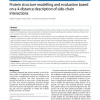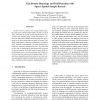100 search results - page 10 / 20 » Predicting protein folds with structural repeats using a cha... |
CSB
2003
IEEE
14 years 28 days ago
2003
IEEE
Recognition of a protein’s fold provides valuable information about its function. While many sequence-based homology prediction methods exist, an important challenge remains: tw...
BMCBI
2008
13 years 7 months ago
2008
Background: Recent approaches for predicting the three-dimensional (3D) structure of proteins such as de novo or fold recognition methods mostly rely on simplified energy potentia...
BMCBI
2010
13 years 7 months ago
2010
Background: Accurate evaluation and modelling of residue-residue interactions within and between proteins is a key aspect of computational structure prediction including homology ...
ICPR
2008
IEEE
14 years 8 months ago
2008
IEEE
In this work we present a new string similarity feature, the sparse spatial sample (SSS). An SSS is a set of short substrings at specific spatial displacements contained in the or...
BMCBI
2005
13 years 7 months ago
2005
Background: The 'lid' subcomplex of the 26S proteasome and the COP9 signalosome (CSN complex) share a common architecture consisting of six subunits harbouring a so-call...


